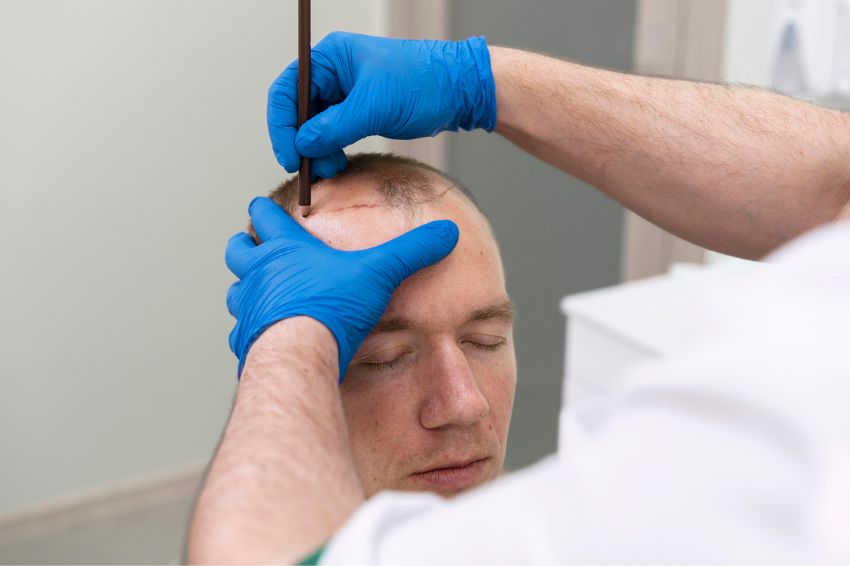



The hair transplant surgeon's skills, experience, and expertise play a vital role in achieving natural-looking hair restoration results.
Choosing an inexperienced or inadequately trained surgeon can damage your hair and scalp, leading to noticeable scarring, unnatural or uneven hairline, and the risk of infection. That's why choosing an experienced and competent hair surgeon is always important.
Let us discuss hair transplants and what to look for when choosing the surgeon.
A hair transplant surgery, also known as hair replacement or restoration, involves replacing hair in the balding/thinning areas. It is often recommended for people who have tried other hair loss treatments, but they fail to produce the expected results.
The hair transplant surgeon extracts grafts (small skin sections) from donor areas (areas of the scalp that possess healthy hair, usually the back of your scalp). After that, the provider transplants these grafts to recipient areas. Once the transplanted skin has fully healed, it will stimulate hair growth.
Consider these factors -
A well-trained and experienced hair transplant surgeon can significantly impact the success and safety of the procedure.
Hair transplantation requires intricate surgical skills, in-depth knowledge of hair anatomy, and an understanding of aesthetic principles so that the surgeon can assess your unique needs, devise a personalized treatment plan, and carry out the procedure with precision and care.
Experience and Expertise
You should inquire about how long the surgeon has been performing hair transplant procedures and how many surgeries they have done.
A surgeon with ample experience is more likely to possess the correct technique, a more profound comprehension of patient requirements, and handle any unforeseen circumstances that may arise during the procedure.
If you have a large thinning or balding area that requires transplanting 2,000 or 3,000 grafts in one session, you must select a surgeon with the necessary expertise to deliver realistic outcomes.
This proficiency guarantees that the surgeon can effectively transplant more grafts while upholding quality and reducing the likelihood of complications.
Exploring patient testimonials and reviews can offer significant knowledge about the surgeon's reputation. By conducting online research, you can gather feedback from previous patients about their overall experience, contentment with the results, and the surgeon's level of professionalism.
A surgeon with a solid reputation and positive reviews from past/existing patients would have consistently performed hair restoration surgeries with successful outcomes and improved patient satisfaction.
Two main techniques are used for hair transplantation: follicular unit transplantation (FUT) and follicular unit extraction (FUE). Although both methods can produce natural-looking results, understanding them can help you make an informed decision.
FUT involves removing a strip of skin from the donor area (usually the back or sides of the head). The strip is then divided into individual follicular units and transplanted into the recipient area. The donor area is then closed with sutures, which results in a linear scar.
Advantages of FUT
Disadvantages of FUT
Follicular unit extraction is an advance method that uses a small, punch-like instrument to extract individual follicular units directly from the donor area. These extracted units are subsequently transplanted into the recipient area of the scalp.
Advantages of FUE
Disadvantages of FUE
While both techniques have their advantages and disadvantages, discussing your options with your surgeon is essential to choosing the method that best suits your needs.
Here is what you should ask your hair transplant surgeon before undergoing the procedure:
You gain insight into their experience and expertise in hair transplant surgeries by asking about their previous cases. Success stories will give you an idea of the surgeon's ability to achieve natural-looking results.
As hair transplant results vary according to the individual's degree, causes, and extent of hair loss, asking about the expected results will help you know what can be achieved through the procedure.
Examining the donor area is indispensable, as it is not just enough for the donor area to have sufficient hair; it should also be genetically resistant to balding.
The quality and quantity of the donor area must be assessed to decide how many hair follicles can be extracted without causing scarring or balding.
The recipient area should be appropriately examined, considering the pattern and degree of hair loss, so the surgeon can decide the best method to transplant the harvested grafts.
Knowing the post-hair transplant care, including hygiene practices, medication, and dietary recommendations, will help you maximize the success and longevity of your hair transplant.
Ask about the follow-up appointments, as they are necessary to evaluate the progress of your transplant and address any complications. Then, ask about the surgeon's availability to your questions/concerns, as it is crucial to get timely assistance to maintain the longevity and success of the procedure.
As you know what factors to look for and what questions to ask, you can select a skilled and experienced hair transplant surgeon. A skilled surgeon will comprehensively understand various hair restoration techniques, assess your needs, and customize a treatment plan.
Get Your Hair Transplant Done by a Competent Hair Surgeon at MHTA
Medical Hair Transplant & Aesthetics is led by a highly skilled and knowledgeable hair surgeon – Dr. John Diep. He has extensive expertise and experience in the field, offering top-notch hair transplants with desired results. Contact us today to regain your dream hairline.